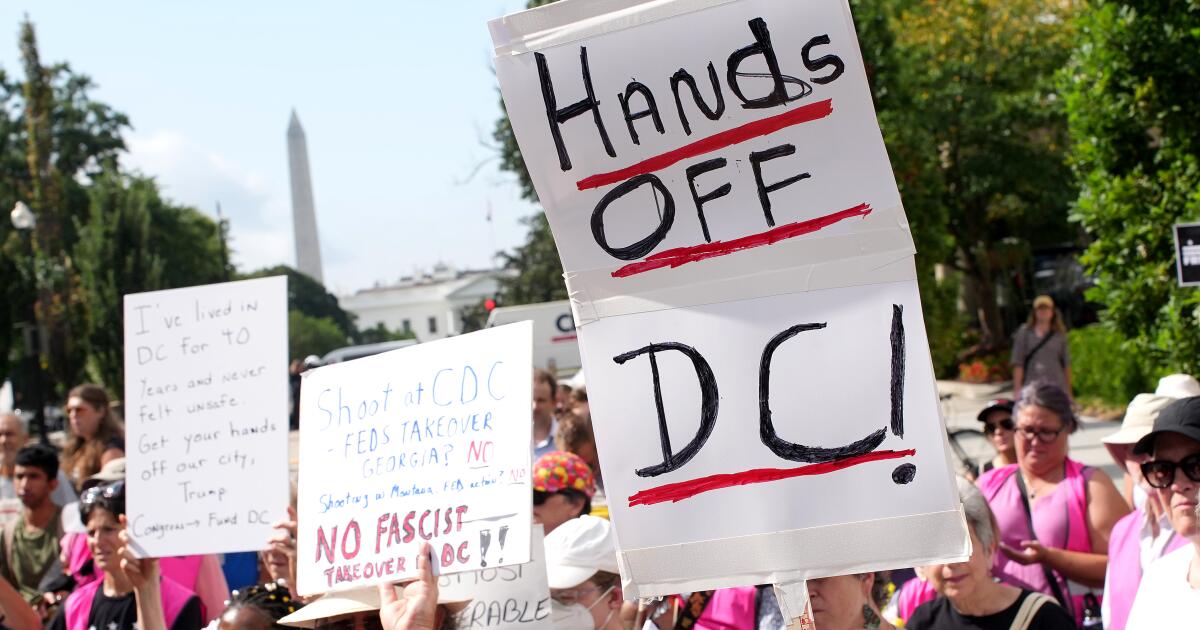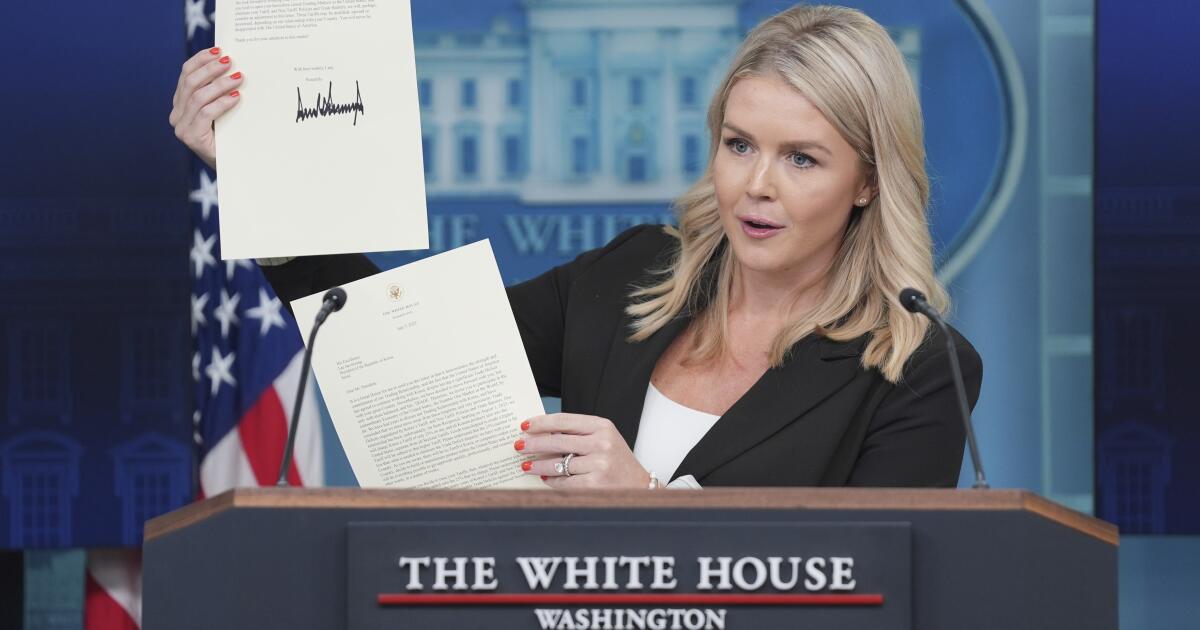Contributor: Of course Trump wants to flex on D.C. Where are the Democrats to stop him?
Remember “I alone can fix it”? Donald Trump, who made that laughable statement in his 2016 convention acceptance speech, is now testing the theory in Washington.
Trump and his party have been threatening a D.C. takeover for years and made it part of the Republican platform last year. But it was all just empty talk and random uppercase words until a former staffer at the Department of Government Efficiency was reportedly attacked in an attempted carjacking in the wee hours of Aug. 3 in a busy area of bars and restaurants.
It doesn’t matter at all to Trump that D.C.’s violent crime rate fell to a 30-year low last year and is down another 26% so far this year compared with 2024, or that a police report suggests police saw the incident and intervened. This particular victim — a teenage Elon Musk protégé and notorious DOGE operative — gave this particular president the “emergency” he needed to declare a “public safety emergency.”
Of course, he called it “a historic action to rescue our nation’s capital from crime, bloodshed, bedlam and squalor and worse.” He has federalized the city’s Metropolitan Police Department and deployed 800 members of its National Guard (to start). Over the weekend he sent 450 federal police officers from 18 agencies to patrol the city.
It’s the second time this year that Trump has played the National Guard card to show who’s boss. He sent 4,000 Guard troops and 700 Marines to Los Angeles in June, over the objections of Gov. Gavin Newsom and Mayor Karen Bass, ostensibly to restore order amid immigration raids. But the move sparked new tensions, protests and at least one surreal foray by armed, masked agents into a park where children were attending summer camp. It also drew a legal challenge from Newsom, which is unfolding in court this week.
There will be no similar lawsuit in D.C., where I’ve lived for decades. That’s because the U.S. president controls our National Guard. The hard truth is that though Wyoming and Vermont each have fewer people than D.C.’s 700,000-plus residents, D.C. is not a state. It’s still in a semi-colonial status, with a mayor and city council whose actions can be nullified by Congress, and with no voting representation in that Congress.
In fact, Congress accidentally slashed $1.1 billion from D.C.’s budget — our own money, not federal dollars! — in its cost-cutting frenzy last spring. A promised fix never came, forcing cuts that affect public safety and much else. And yet the city’s crime rate has continued to fall.
Compared with California, an economic juggernaut of more than 39 million people located thousands of miles from Washington, D.C. is a minuscule and all too convenient target for an executive aiming to prove his manhood, show off to autocrats in other countries or create headlines to distract from news he doesn’t like.
I could go off on Trump for his lies, overreach and disrespect for D.C. and its right to govern itself. Or the various Republicans who have imposed conservative policies on D.C. for years and now are trying to repeal its home rule law.
But what really enrages me is the lack of Democratic nerve — or even bravado — that has left D.C. so vulnerable to Trump and conservative-run Congresses. Where was the modern-day Lyndon Johnson (the “master of the Senate,” in Robert Caro’s phrase) in 2021, to whip support in the narrowly Democratic Senate after the House passed a D.C. statehood bill for the second year in a row?
Trump has no mastery beyond bullying and bribery — but those tactics are working fine with Congress, corporations, law firms, academia and sovereign nations across the globe. As former House Speaker Newt Gingrich put it last week: “You have this rock standing in the middle of history called Donald Trump. And he’s saying: ‘Do you want to do it my way, or do you want to be crushed? I prefer you do it my way, but if you have to be crushed, that’s OK.’ ”
Gingrich correctly characterized most responses to Trump as “You know, I’ve always wanted to be part of the team,” and added: “If he can sustain this, he’s moving into a league that, other than Washington and Lincoln, nobody has gotten to the level of energy, drive and effectiveness that we see with Trump.”
Unfortunately, Trump is aiming to speed-raze what Washington and Lincoln built. (He keeps claiming it’s “Liberation Day” for D.C., but the last “Liberation Day” — his April 2 tariff announcements — tanked the stock market.) The only conceivable antidote is to elect a mad-as-hell Democratic Congress in 2026 and, in 2028, an arm-twisting, strong-arming, terror-inspiring Democratic president who’s in a hurry to get things done. Someone who’s forceful, persuasive and resolved to use the power they have while they have it.
The top priorities, beyond reversing as much institutional and constitutional damage as possible, should be structural: Supreme Court term limits and ethics rules with teeth, a national gerrymandering ban, a sensible and uniform national voter ID policy, and minimum national standards for early voting and mail voting — to protect the will of the people and the republic itself.
Equally important, make D.C. the state of Douglass Commonwealth, named after the abolitionist Frederick Douglass rather than the colonizing Christopher Columbus. Rural America has wielded disproportionate power since the late 1800s, when Republicans added sparsely populated states and permanently skewed the Senate. Two new D.C. senators would help correct that imbalance.
The problem is that the next president, or even the next Congress, might arrive too late for D.C. Trump has already begun the federal takeover he has threatened so often for so many years. He took over the Kennedy Center. He took over Congress. We should have expected we’d be next.
Back in March, Rep. Jamie Raskin (D-Md.) proposed that D.C. seek temporary sanctuary with Maryland, which ceded most of the land to create the capital in the first place. “You’d definitely be safer,” he said he told Mayor Muriel Bowser.
That offer, joke or not, practical or not, is looking increasingly inviting by the day.
Jill Lawrence is a writer and author of “The Art of the Political Deal: How Congress Beat the Odds and Broke Through Gridlock.” @jilldlawrence.bsky.social



